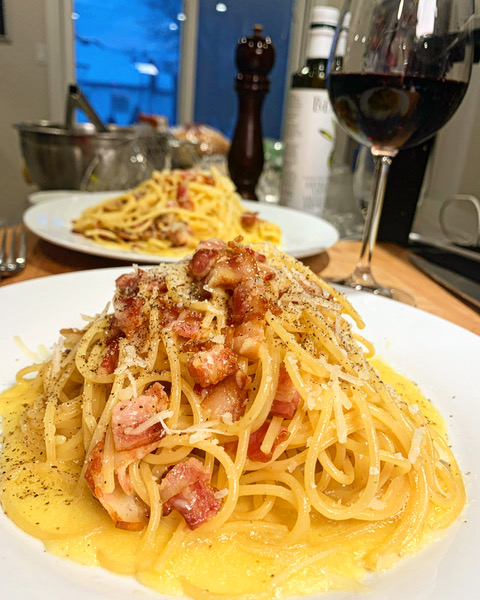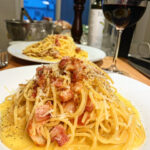This post contains affiliate links
The Perfect Pasta Carbonara Recipe: A Chef’s Guide
Pasta Carbonara is a dish that sparks debate. Should it have cream? (No.) Should you use pancetta or bacon? (Both work.) Is it complicated to make? (Not if you know the tricks.) As a chef, I love Carbonara for its simplicity. It’s a dish built on technique, not ingredients. Get that right, and you’ll have a rich, silky sauce that clings perfectly to the pasta. Get it wrong, and you’ll end up with scrambled eggs. Let’s make sure you get it right.
What Is Pasta Carbonara?
Carbonara is a classic Roman dish made with pasta, eggs, cheese, cured pork, and black pepper. No cream, no garlic, no extras. The magic happens when the heat of the pasta gently cooks the eggs, creating a luscious, velvety sauce. It’s the ultimate (but effortless) comfort food.
The Italian Secret: Simplicity and Quality Ingredients
Italian cooking is difficult in its simplicity. There are no heavy sauces or complicated techniques to hide behind—just a few key ingredients that must be the best you can find. That’s the true secret to Italian food: using fewer ingredients but making them count.
For pasta carbonara, this means:
- Fresh eggs – Free-range, high-quality eggs create a richer, silkier sauce.
- Real cheese – Pecorino Romano or Parmigiano-Reggiano, freshly grated, no pre-packaged shreds.
- Pasta with bite – Bronze-cut, high-quality dried pasta holds onto the sauce better.
- Properly cured pork – Pancetta, guanciale, or thick-cut bacon with depth of flavor.
- Freshly cracked black pepper – Not the pre-ground kind; you need that bold, peppery kick.
When ingredients are this simple, each one must be exceptional. This is why Italian cooking isn’t about shortcuts—it’s about respect for the process and the ingredients.
Other Simple Italian Dishes You’ll Love
Pasta carbonara isn’t the only Italian dish that shines in its simplicity. Here are a few more classic recipes that rely on just a handful of high-quality ingredients to deliver incredible flavour:
Cacio e Pepe – The Ultimate Cheese and Pepper Pasta
A dish even simpler than carbonara, cacio e pepe (cheese and pepper) is pure magic with just three ingredients: pasta, Pecorino Romano, and freshly cracked black pepper. The secret? Using starchy pasta water to emulsify the cheese into a creamy, clinging sauce.
Aglio e Olio – Garlic and Olive Oil Perfection
Needing only garlic, olive oil, chili flakes, and pasta, aglio e olio is a late-night Italian favorite. The key? Gently cooking the garlic in olive oil to release its flavor without burning it, then tossing everything together with a splash of pasta water for a silky finish.
Pasta al Limone – Bright, Buttery, and Irresistible
Lemon zest, butter, Parmesan, and pasta water create a luscious, citrusy sauce in pasta al limone. It’s light, creamy, and vibrant—proof that a few simple ingredients can transform into something truly special.
Puttanesca – Bold, Briny, and Irresistible
With tomatoes, olives, capers, garlic, and anchovies, spaghetti alla puttanesca packs a punch of flavour with minimal effort. It’s salty, tangy, and deeply satisfying.
Master these dishes, and you’ll unlock the true power of Italian simplicity in your kitchen.
Cook With Us!
Like this recipe? You should try cooking with us! Start with an on-demand pre-recorded class, or jump in to the best experience with our live classes!
I subscribe the updates and get links to recipes - I recently made the Olive Oil Lemon cake. It turned out delicious – as you said in the description, very moist! My daughter has a birthday in strawberry season and typically she asks for strawberry shortcake with a traditional shortcake recipe… I served the lemon came this weekend with a bit of whipping cream and fresh strawberries (your picture was quite enticing) and her comment was that her birthday request this year would be to replace the traditional shortcake with this recipe!
I made Dan Dan noodles last month and again referred to the recording as it has been awhile. I was grateful for the reminders, tips and tricks. Not to mention, I love to cook with Kirstie and Jody. They make it so much fun!
Most of the meals I make are from your repertoire. I think I have close to 60!
You will learn delicious recipes taught in real time from start to end by two good friends who want nothing more than to teach you how to cook and and have fun doing it. Class presentation is practical and encouraging with one chef starting and one playing 'catch up' so you do not miss anything and no question will go unanswered!
The recipe with food pack is perfectly packaged and always arrives on time to make it easy so you do not have to shop!
Several recipes from the Culinary Studio are in our regular rotation!
Excited to keep cooking with you Kirstie and Jody!
I was at the Studio for the very first class they held and I have continued to take classes for the past 13 years. While some things have changed over the years, the quality, knowledge and skills Jody and Kirstie bring to each class has not.The skills I learned through the their instruction have been used daily.
How to Cook Pasta Perfectly Al Dente
Cooking pasta might seem straightforward, but getting it perfectly al dente takes some attention to detail. Here’s how to do it like a chef:
- Use a large pot – Pasta needs room to move. Use at least 4-5 quarts of water per 250g of pasta.
- Salt the water generously – Add 3 tablespoons of salt per gallon of water. It should taste like the sea!
- Wait for a rolling boil – Adding pasta too early (before the water is boiling) leads to uneven cooking.
- Stir occasionally – Prevents sticking and ensures even cooking.
- Taste-test for doneness – Check 1-2 minutes before the package time. It should be firm to the bite but not crunchy.
- Save pasta water – This starchy liquid helps bind the sauce together beautifully.
Why Seasoning Pasta Water is Crucial
Salted water isn’t just about taste—it’s essential to good pasta. Pasta absorbs water as it cooks, and if that water is bland, the pasta will be too. Well-seasoned water enhances the flavour of the final dish without needing excessive salt later.
To make authentic Pasta Carbonara, here’s what you need:
- Prep Time: 10 minutes
- Cook Time: 15 minutes
- Total Time: 25 minutes
- Yield: 4 servings
- Category: Main Course
- Method: Boiling
- Cuisine: Italian
Ingredients
- 250g spaghettini (or spaghetti)
- 1/4 lb (6 slices) bacon (or pancetta)
- 2 tbsp butter
- 2 tbsp olive oil
- 2 eggs + 1 yolk
- Plenty of kosher salt and freshly ground black pepper
- 1/2 cup grated cheese (Parmesan or Pecorino Romano) + more for serving
Instructions
- Get the Water Boiling: Fill a large pot with water and set it over high heat. This is your first step because you’ll need boiling water ready when it’s time to cook the pasta.
- Cook the Bacon: In a large frying pan, heat the olive oil and butter over medium heat. Add the bacon and cook slowly, letting the fat render. You want it crisp at the edges but still slightly chewy.
- Prep the Eggs and Cheese: In a medium bowl, whisk together the eggs, yolk, salt, and a generous amount of black pepper. Stir in half the grated cheese. Set aside.
- Cook the Pasta: Once the water is boiling, add 3 tablespoons of salt (yes, really—it seasons the pasta properly). Add the pasta and cook until al dente, about 7 minutes.
- Bring It All Together: Using tongs, lift the pasta directly from the water and drop it into the pan with the bacon. Toss well to coat in the fat. Transfer everything to the bowl with the eggs and cheese. This is where the magic happens. The residual heat will cook the eggs, turning them into a creamy sauce. Add 1/2 cup pasta water to loosen it up. Toss vigorously.
- Serve Immediately: Top with extra cheese and more black pepper. Carbonara waits for no one—eat it right away!
Notes
Substitutions
- Pancetta instead of bacon – More traditional and slightly less smoky.
- Pecorino Romano instead of Parmesan – This is the classic Roman cheese, sharper and saltier.
- Guanciale instead of bacon or pancetta – The real-deal Italian way.
- Gluten-free pasta – Works fine, but avoid overly starchy brands.
What to Know/Avoid in This Recipe
- Don’t add cream. The eggs create the creamy texture—trust the process.
- Avoid overcooking the eggs. If they scramble, the pan was too hot.
- Use enough black pepper. It’s a key flavour in Carbonara.
- Salt the pasta water heavily. This is your main seasoning.
- Don’t drain the pasta in a colander. The starchy water is essential for emulsifying the sauce.
Storage Recommendations
Carbonara is best eaten fresh, but if you have leftovers:
- Fridge: Store in an airtight container for up to 24 hours.
- Reheat gently: Use a pan over low heat with a splash of water to loosen the sauce. Avoid the microwave—it’ll ruin the texture.
FAQ
Can I make Pasta Carbonara without pork?
Yes! Try sautéing mushrooms for a vegetarian twist or using smoked salmon for a different flavour.
Why did my sauce turn into scrambled eggs?
The heat was too high. Make sure the pasta isn’t scorching hot when mixing it with the eggs.
Can I make this in advance?
Not really. Carbonara is best fresh, as the sauce thickens and loses its silky texture over time.
Can I use whole eggs instead of yolks?
Yes, but adding one extra yolk makes the sauce richer and creamier.
Take Your Cooking to the Next Level!
Love this recipe? Learn from a chef and bring restaurant-quality meals to your kitchen with our online cooking classes! Choose the option that fits your lifestyle:
👩🍳 Live Cooking Classes – Cook alongside a chef in real time and get expert guidance. Join a Live Class
📺 On-Demand Classes – Learn at your own pace with step-by-step video lessons. Start Cooking Anytime








